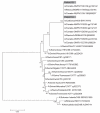Identification and epidemiology of severe respiratory disease due to novel swine-origin influenza A (H1N1) virus infection in Alberta
- PMID: 22132007
- PMCID: PMC3009582
- DOI: 10.1155/2010/293098
Identification and epidemiology of severe respiratory disease due to novel swine-origin influenza A (H1N1) virus infection in Alberta
Abstract
Background: In March 2009, global surveillance started detecting cases of influenza-like illness in Mexico. By mid-April 2009, two pediatric patients were identified in the United States who were confirmed to be infected by a novel influenza A (H1N1) strain. The present article describes the first identified severe respiratory infection and the first death associated with pandemic H1N1 (pH1N1) in Canada.
Methods: Enhanced public health and laboratory surveillance for pH1N1 was implemented throughout Alberta on April 24, 2009. Respiratory specimens from all patients with a respiratory illness and travel history or those presenting with a severe respiratory infection requiring hospitalization underwent screening for respiratory viruses using molecular methods. For the first severe case identified and the first death due to pH1N1, histocompatibility leukocyte antigens were compared by molecular methods.
Results: The first death (a 39-year-old woman) occurred on April 28, 2009, and on May 1, 2009, a 10-year-old child presented with severe respiratory distress due to pH1N1. Both patients had no travel or contact with anyone who had travelled to Mexico; the cases were not linked. Histocompatibility antigen comparison of both patients did not identify any notable similarity. pH1N1 strains identified in Alberta did not differ from the Mexican strain.
Conclusion: Rapid transmission of pH1N1 continued to occur in Alberta following the first death and the first severe respiratory infection in Canada, which were identified without any apparent connection to Mexico or the United States. Contact tracing follow-up suggested that oseltamivir may have prevented ongoing transmission of pH1N1.
HISTORIQUE :: En mars 2009, le réseau de surveillance mondial a commencé à détecter des cas de maladie pseudogrippale au Mexique. En date de la mi-avril 2009, on a confirmé aux États-Unis deux cas pédiatriques d’infection par une nouvelle souche du virus de la grippe A H1N1. Le présent article décrit la première infection respiratoire grave et le premier décès associés à la pandémie de grippe A H1N1 (H1N1pdm) au Canada.
MÉTHODE :: Le 24 avril 2009, sur tout le territoire de l’Alberta, les autorités de santé publique ont instauré un système amélioré de surveillance par analyses de laboratoire pour le dépistage de la grippe H1N1pdm. On a soumis des spécimens respiratoires de tous les patients atteints de maladies respiratoires et ayant voyagé ou présentant une grave infection respiratoire nécessitant une hospitalisation à un dépistage des virus respiratoires à l’aide de techniques moléculaires. Ces mêmes techniques ont servi à comparer les systèmes HLA du premier cas grave recensé et du premier décès attribués au H1N1pdm.
RÉSULTATS :: Le premier décès (une femme de 39 ans) est survenu le 28 avril 2009, et le 1er mai 2009, un enfant de dix ans a présenté une grave maladie respiratoire causée par le virus H1N1pdm. Aucun de ces deux patients ne s’était rendu au Mexique ni n’avait eu de contact avec qui que ce soit en provenance de ce pays et les deux cas n’étaient pas reliés. La comparaison des systèmes HLA des deux patients n’a pas permis d’établir une similarité notable. Les souches H1N1pdm identifiées en Alberta n’étaient pas différentes de la souche mexicaine.
CONCLUSIONS :: La transmission rapide du H1N1pdm a continué de se produire en Alberta après le premier décès et le premier cas grave d’infection respiratoire recensés au Canada, qui se sont révélés sans lien apparent avec les cas recensés au Mexique ou aux États-Unis. La recherche des contacts donne à penser que l’oseltamivir peut avoir empêché la propagation du H1N1pdm.
Keywords: Influenza; Pandemic; pH1N1.
Figures




Similar articles
-
Pandemic H1N1 influenza virus in Chilean commercial turkeys with genetic and serologic comparisons to U.S. H1N1 avian influenza vaccine isolates.Avian Dis. 2011 Dec;55(4):633-41. doi: 10.1637/9760-041511-Reg.1. Avian Dis. 2011. PMID: 22312984
-
A comparison of the epidemiology and clinical presentation of seasonal influenza A and 2009 pandemic influenza A (H1N1) in Guatemala.PLoS One. 2010 Dec 30;5(12):e15826. doi: 10.1371/journal.pone.0015826. PLoS One. 2010. PMID: 21209850 Free PMC article.
-
Respiratory viruses identified in an urban children's hospital emergency department during the 2009 influenza A(H1N1) pandemic.Pediatr Emerg Care. 2012 Oct;28(10):990-7. doi: 10.1097/PEC.0b013e31826ca980. Pediatr Emerg Care. 2012. PMID: 23023466
-
Characterization of H1N1 swine influenza viruses circulating in Canadian pigs in 2009.J Virol. 2011 Sep;85(17):8667-79. doi: 10.1128/JVI.00801-11. Epub 2011 Jun 22. J Virol. 2011. PMID: 21697484 Free PMC article.
-
Notes from the field: outbreak of 2009 pandemic influenza A (H1N1) virus at a large public university in Delaware, April-May 2009.Clin Infect Dis. 2009 Dec 15;49(12):1811-20. doi: 10.1086/649555. Clin Infect Dis. 2009. PMID: 19911964
References
-
- Centers for Disease Control and Prevention Swine influenza A (H1N1) infection in two children – southern California. Mar–Apr. 2009. < http://www.cdc.gov/mmwr/preview/mmwrhtml/mm58d0421a1.htm?s_cid=mm58d0421...> (Accessed on June 29, 2010). - PubMed
-
- Public Health Agency of Canada < http://www.phac-aspc.gc.ca/alert-alerte/h1n1/surveillance-archive/200904...> (Accessed on June 29, 2010).
-
- World Health Organization < http://www.euroflu.org/cgi-files/bulletin_v2.cgi> (Accessed on June 29, 2010).
-
- Dawood FS, Jain S, Finelli L, et al. Emergence of novel swine origin influenza A (H1N1) virus in humans. N Engl J Med. 2009;360:2605–15. - PubMed
-
- Kumar A, Zarychanski R, Pinto R, et al. Critically ill patients with 2009 influenza A (H1N1) infection in Canada. JAMA. 2009;302:1872–9. - PubMed
LinkOut - more resources
Full Text Sources
Miscellaneous

